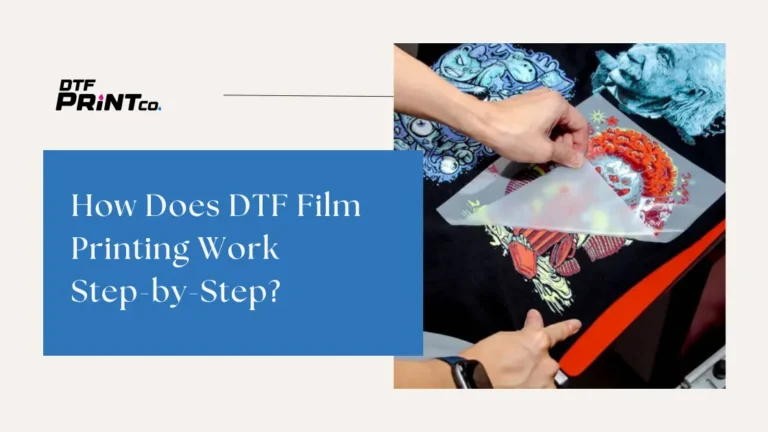
DTF vs DTG Printing: Which Is Better for T-Shirts?
Both DTF (Direct-to-Film) and DTG (Direct-to-Garment) printing are popular methods for customizing t-shirts, but each method has its strengths. DTF printing works well on various

DTF transfer has gained significant traction in custom print shops. This innovative printing method allows for vibrant, durable prints on various fabrics, making it a popular choice for both businesses and individual consumers. As the demand for customized apparel and merchandise continues to rise, more shops are adopting DTF transfer due to its numerous advantages over traditional printing methods. Let’s explore why DTF transfer is becoming a favorite among print shops and customers alike.
DTF stands for Direct to Film. This printing technique involves transferring ink onto a special film and then applying it to fabric. The process is simple yet effective:
This method is popular because it produces high-quality prints that last. It works well on various materials, including cotton, polyester, and blends.
Several factors contribute to the rise of DTF transfer in custom print shops:
One of the main reasons for the growing popularity of DTF transfer is the high-quality prints it produces. DTF printing creates sharp and vivid designs that stand out. The colors remain vibrant even after many washes, making it an ideal choice for items like t-shirts, hoodies, and other apparel. Customers want their designs to look good and last, and DTF transfer delivers on both fronts.
DTF transfer is incredibly versatile. It can print on various fabrics, including cotton, polyester, blends, and even some specialty materials. This flexibility allows print shops to cater to different customer needs, whether they are producing custom t-shirts for an event, promotional items for a business, or personalized gifts. The ability to print on multiple surfaces expands the range of products that can be offered.
Compared to other printing methods, DTF transfer can be more affordable, especially for small batch orders. Print shops can produce small batches without a significant upfront investment. This is ideal for businesses that are just starting or those with lower demand. Additionally, the cost savings are passed on to customers, making customized products more accessible.
The DTF process is straightforward. Print shops can quickly learn and implement this technique, which helps them fulfill orders faster. The setup is less complicated than screen printing, which requires more equipment and preparation. This efficiency translates to quicker turnaround times for customers, allowing them to receive their orders sooner.
Many DTF inks are water-based and less harmful to the environment compared to traditional plastisol inks used in screen printing. As customers become more eco-conscious, this aspect of DTF transfer becomes increasingly appealing. Print shops that use environmentally friendly inks can attract customers who prioritize sustainability in their purchasing decisions.
For customers, DTF transfer offers several advantages:
DTF transfer is not the only printing method available. Here’s how it compares to other popular options such as screen printing and direct-to-garment (DTG) printing:
| Method | DTF Transfer | Screen Printing | DTG Printing |
| Setup Cost | Low | High | Medium |
| Print Quality | High | High | Very High |
| Material Flexibility | High | Medium | High |
| Production Speed | Fast | Slow | Medium |
As shown in the table, DTF transfer combines quality and affordability, making it a strong choice for custom print shops. While screen printing is often preferred for large runs and DTG is ideal for intricate designs, DTF offers a balanced solution for smaller orders without sacrificing quality.
When looking for a custom print shop that offers DTF transfer, consider the following tips:
The future of DTF transfer looks bright. As technology advances, we can expect improvements in print quality and efficiency. More print shops may adopt this method, leading to even greater accessibility for customers. Innovations may also lead to even more eco-friendly options in the industry, aligning with consumer preferences for sustainable products.
DTF transfer involves printing on a film and transferring it to fabric, while DTG (Direct to Garment) prints directly onto the fabric. DTG is typically better for complex designs but can be more expensive.
Yes, DTF prints are durable and can withstand multiple washes if cared for properly. Follow the washing instructions provided by the print shop to ensure longevity.
Many DTF inks are water-based, making them a more environmentally friendly option compared to traditional inks. This eco-friendly approach is becoming increasingly important to consumers.
Turnaround times vary by shop, but DTF transfers typically allow for quicker production than other methods. Check with your chosen shop for specific timelines.
Yes, DTF transfer works well on both light and dark fabrics. The prints provide excellent opacity and vibrancy, ensuring that your design stands out regardless of the fabric color.
The growing popularity of DTF transfer in custom print shops showcases its many benefits. From high-quality prints to cost-effectiveness, this method is here to stay. If you’re considering custom printing, look for a shop that offers DTF transfer. Your unique designs deserve to shine!

Both DTF (Direct-to-Film) and DTG (Direct-to-Garment) printing are popular methods for customizing t-shirts, but each method has its strengths. DTF printing works well on various

Direct To Film (DTF) printing is rapidly becoming a popular choice for custom apparel and garment decoration. Unlike traditional screen printing or direct-to-garment (DTG) methods,

If you’ve ever dreamed of creating your own custom shirts, hoodies, or tote bags without spending a fortune or dealing with messy screens, there’s some

2023 - 2024 © ALL RIGHTS RESERVED